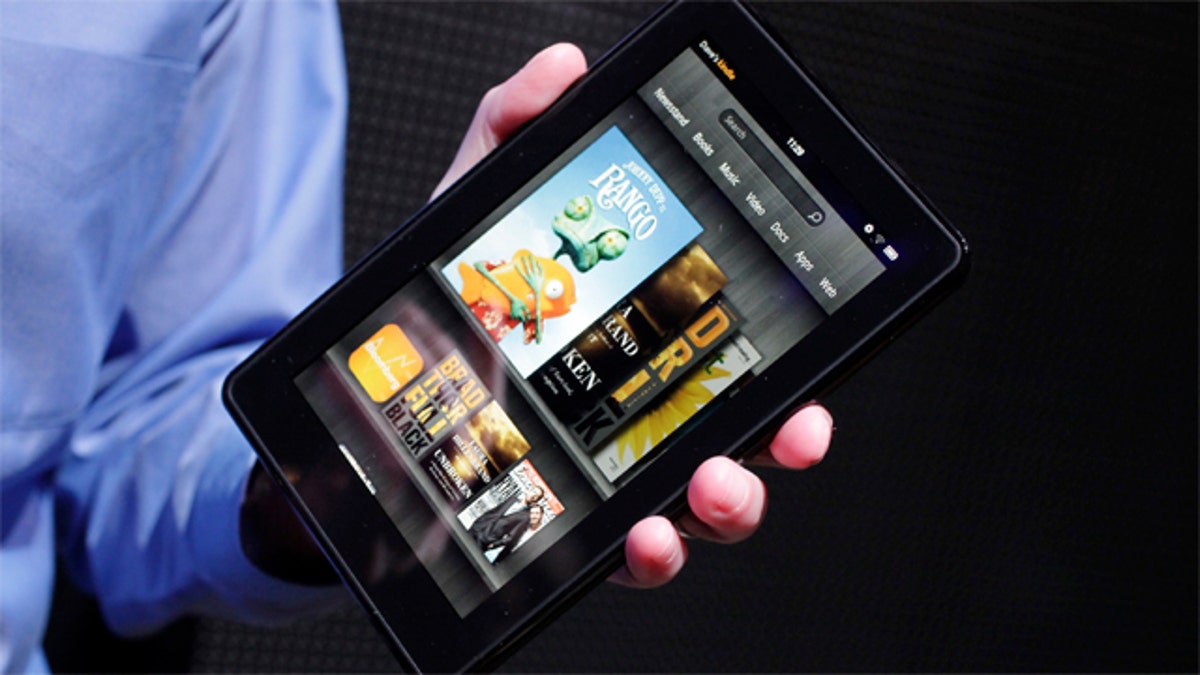
Amazon looks to have a strong holiday season with its new Kindle Fire tablet. (AP Photo/Mark Lennihan)
The Kindle Fire is burning up the charts.
Purported pre-sales of the newly announced Kindle Fire by Amazon suggest the tablet is on track to outsell the iPad in first-month sales. If accurate, that’s big -- really big. So far, competing brands have done nothing to rival Apple’s splash nor dominance of the growing tablet market. The Fire is the first real competitor.
Apple iPad sales are as brisk as ever, of course, but there’s plenty of reason for the excitement surrounding the all-new, color screen, touch-enabled Kindle Fire. To borrow an Apple word, it’s different. But it’s also similar enough to the iPad that a lot of consumers might view it as a worthy alternative -- indeed, something better.
1. Eye-popping affordability. At $199, the Kindle Fire sells for less than half the price of the iPad, which starts at $500. So for every entry-level iPad bought and sold, you could buy two and a half Fires. That alone is turning heads, especially since the previously released and uninspired iPad clones have tried to charge as much as Apple for a much less desired product.
2. A lot more content. Content is king. And iPad may be king of the apps, but Kindle Fire bests it considerably by volume of content. The Fire will have immediate access to the 18 million movies, TV shows, songs, magazines, and books already available on Amazon’s easy-to-browse virtual shelves.
Apple doesn't cite how many TV shows or songs are available, but the number appears to be far less in anecdotal searches.
Want to rent instead of buy? There’s an app ... er, a solution for that, too: 10,000 movies and TV shows can be streamed instantly. Those numbers are huge, and growing every day.
3. Free storage. If you want to take all your content with you, the entry-level iPad and its puny 16 gig storage drive leaves a lot to be desired. You can buy more, but it’ll cost you. Which is why the Fire’s sales pitch -- free cloud storage for all your Amazon content -- is so enticing, especially since Amazon is already the no. 1 digital bookstore, the no. 2 mp3 store (behind Apple), and high on the list in other categories.
For content you don't buy from Amazon, there are about 6 gigs of free space on the Fire to do with as you please.
4. Democratized apps. One of the biggest knocks on the Apple AppStore is that it’s a closed system—if Apple doesn’t like your stuff, no app for you. One of the biggest knocks on the Google Android software powering nearly every other tablet out there is that it's too open—you’re required to sift through a lot of junk to get to the goods.
The Kindle Fire hopes to bridge that gap with the Amazon Appstore, which remains open like Android, but only makes available the very best and most popular apps from the open market. The result: More free apps without the hassle, the best of both worlds approach.
5. Easier to hold. The 10-inch iPad is a lot of fun, but hard to handle with one hand due to its weight and size. The 6-inch Kindle reader, on the other hand, is a lot easier to hold. With only one hand, you can hold it for several hours without fatigue. The new 7-inch Kindle Fire promises the same: capable of being held with one hand, lighter than the iPad, and a lot more portable.
All of those pros don’t come without sacrifices, however. The Fire’s screen is 3” smaller than the iPad, which might not make it as ideal a device for watching movies or playing HD games (that’s to be seen, though). Furthermore, the Fire lacks a lens and microphone, so it won’t be able to snap photos, shoot video, or accept video calls.
But for $300 less, those are things I bet a lot of people can live without.
The Kindle Fire goes on sale Nov. 15 for $199.
About the author: Blake Snow is a freelance writer, media consultant, and proud owner of both the iPad and 3G Kindle. He lives in Utah with his family. Contact information and clippings can be found on his website: blakesnow.com
